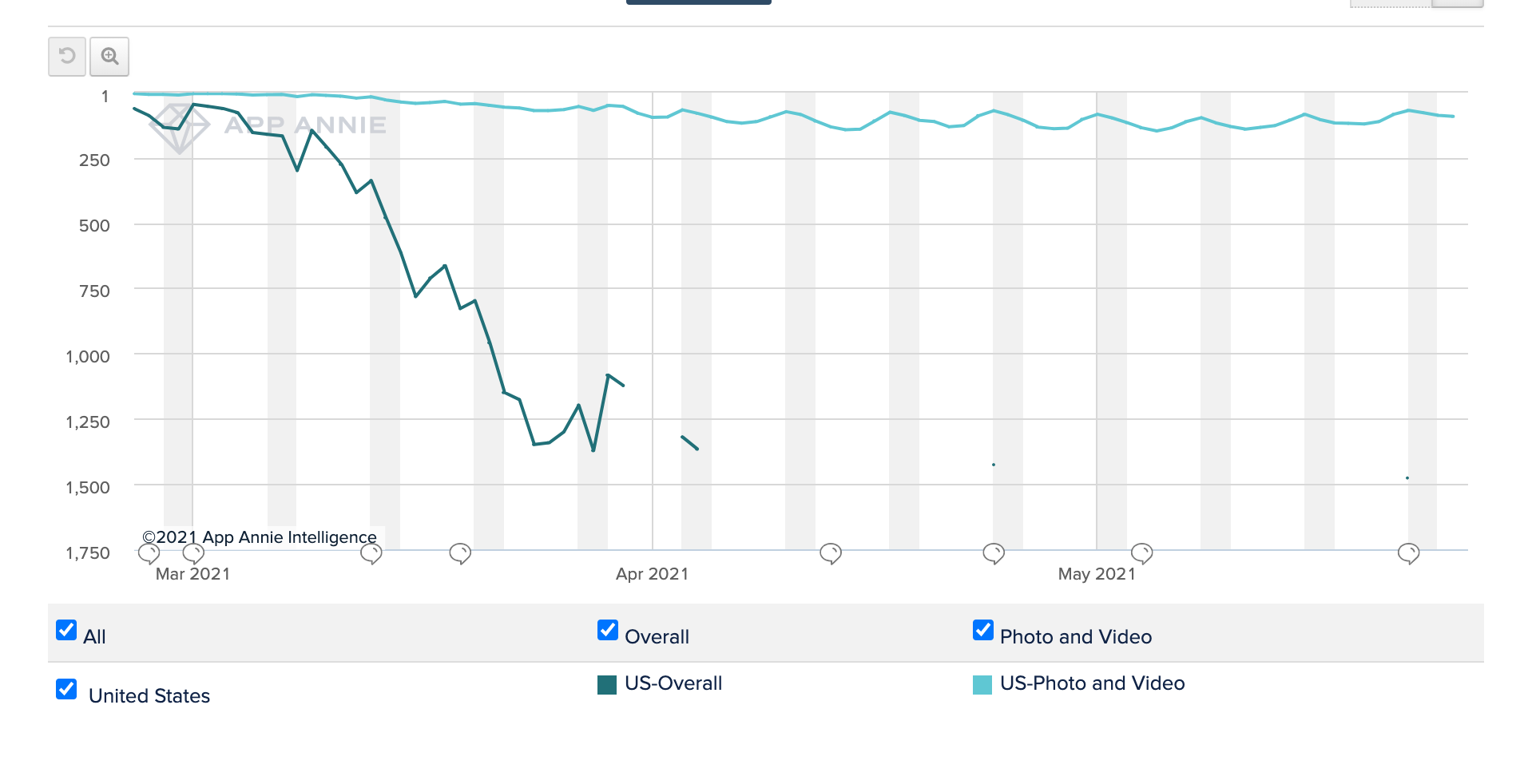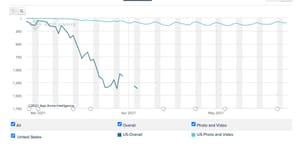Do you remember Dispo? Apparently it was going to be the Future Of Tech, and the Future of Photo Sharing as recently as February. In March, everybody was talking about it. Their CEO (vlogger David Dobrik) was forced to step down among massive allegations of sexual assault against a member of his “vlog squad” in March, which led to people piling on the app in the reviews, and one might say led to a slide in ratings, if of course you want to ignore reality. The app that was supposedly redefining the way in which we take photos by making them take 24 hours to appear had its best day on the app store on March 1 according to data from AppAnnie, when it was 46 in all free apps on the App Store, and 5 in all Photo & Video apps. It hasn’t even charted in all free apps since Apr 4 2021, when it was at 1366 in free apps. Nevertheless, investors rushed in to fund it with mediocre due diligence because they were afraid of being left behind.

The latest frothy app to receive the “next big thing” treatment is Poparazzi, an app that allegedly is blowing up because it doesn’t let you use the front-facing camera on your phone. It’s a social network that doesn’t show you follower counts, doesn’t let you edit pictures, it automatically follows everyone in your phone book, and I dunno, it’s an app. Josh Constine wrote about it with his trademark froth, suggesting that “the future of social is multiplayer,” a statement that - and I say this respecting Josh otherwise - means absolutely nothing and only serves to promote a trend he’s suggesting about how various startups that he likes are “multiplayer experiences,” as in you do them with your friends, which is like…I’m tired, man, I get it, people want to use tech to hang out, just write that.
I’m also curious as to how it got to number 1 so quickly. TTYL has thrown a few products at the wall before, and the sheer level of popularity of the app is impressive. But I have to wonder exactly how it got there, as very few things shoot to the top of the charts with very little press fanfare - what got it there? Advertising? TikTok virality? Perhaps it was the joker?
Anyway, I have no idea, and Constine doesn’t attempt to explain, but he specifically mentions five companies as proof of the multiplayer social effect, with the incredible caveat of “these apps don’t always succeed, but they inspire us to think beyond single-player experiences…”
Let’s do a quick evaluation of their popularity:
- Squad: Screensharing as a way to hang out: (Shut down acquisition)
- Houseparty: Group video chat as the default: (Currently ranked 34 in social networking and 579 in overall free apps - also acquired by Epic)
- Dispo: Collaborative photo albums (unranked in all free apps, 92 in US photo & video)
- Clubhouse: Multiple speakers hashing out ideas (iOS: 570 all free apps, 32 in social networking, allegedly a “disruptor” - on Android they allegedly had 1 million downloads, and millions more on the waitlist…but they’re already dropping, they’re out of the top 100 in Android apps rankings, but hey, give them a chance? I guess?)
- TikTok: Remixes, duets, and stitches breathe crowdsourced life into memes (As I wrote yesterday, Tiktok isn’t even a social network, and it’s multiplayer in the same way that screenshotting people’s tweets is)
Now, not to be that guy, but if things are the future of X Y Z, they generally don’t pop and drop off of the app store like this. I realize that the app store download rankings of an app are generally not the be-all-end-all of consumer behavior, but it’s generally some sort of sign that something is both catching on and staying interesting, and none of these apps (sans TikTok) seem to actually have any lasting staying power, partly because they seem to be built entirely to raise funding, get press and ideally an exit before the inevitable drop-off. Lasting consumer apps are extremely hard to sustain because they’re inevitably built for such a wide swath of people that marketing, attracting and sticking with any particular demographic is difficult, let alone almost every single one.
It is very much a case of people in their 20s and 30s being funded by people in their 30s, 40s and 50s trying to make products for people who are 12 to 17 years old, while also creating a product that appeals fiscally to the 30-50 crowd with all the money. There has been a desperation since the Instagram acquisition within the tech sect - especially in the media and investment circles - to be “first” to the next big consumer app, which brings with it a pathetic sheen of “how do you do, fellow kids?”
While I can’t speak to the mind of a teenager - I have never been cool a single day in my life - I can only imagine that the appeal of an app touted by someone in their late 20s or early 30s as “the next big thing for teens” is inherently embarrassing. Taylor Lorenz is one of the few that’s been able to successfully cover anything to do with teens and tech by writing about it relatively bluntly, with little in the way of dramatics or sizzle, and on some level because it was big because of Dobrik, not because it was an app for teens - and I don’t think New York Times reporters choose their own headlines - if I’m wrong please reach out to me at whocares@shutdafakkup.org.
Silicon Valley on the other hand fawns over anything that might resemble the future of how young people communicate, no matter how flimsy the utility and/or spuriously it connects with the younger generation. There was Color, Viddy, YikYak, Whisper, TBH, FrontBack, Ello…there are entire graveyards of careers and capital that have existed chasing the same dragon of trying to be the next Instagram, the next Facebook, the next Snap, the next something, all created for hip young people by people older than them trying to do a Steve Jobs “I know what people want before they know they do” thing with significantly less talent and foresight.
Poparazzi seems to lack any of the hallmarks of anything lasting. There is nothing new to the mode, nothing that cannot be done elsewhere, nothing truly unique or interesting. Restricting what you can do in a social network works with the length of a video, but it doesn’t really work with photos. It’s just another app that will be gone in a few months, likely after raising a high valuation based on nothing other than the fast and loose venture capital that tends to follow a sudden, unexplained success. Where Clubhouse grew out of a manufactured, A16Z-led influencer campaign, Poparazzi seems to have popped out of thin air, and people will explain this by saying it’s “the next big thing” versus “probably paid advertising or some weird viral bullshit.” Perhaps I’m too cynical, but it feels even more manufactured for acquisition than Clubhouse - a sudden superstar built by a little company trying to growth hack their way into an exit, and honestly, I kind of appreciate the hustle. If a VC is desperate and disconnected enough to shove capital into this, take their money.
The desperation to try and guess the next big teen app sensation is likely there to mask how many simply didn’t take the rise of the teen influence seriously. The influencer generation skews younger, and I think that a lot of people (myself included) disregarded the new generation of famous teens as nothing more than the Leyawn Teen Roast photoshop.
Those in the investment and media space that are now having to play catchup are, I imagine, anxious that they have missed the chance to be up with the trends, and are now desperate to be on top of trends and claim that they’re the future, even if that isn’t the case. There’s also the people that are terrified that they’ll miss the next Instagram, Snap or TikTok, and will throw money and eyeballs at anything that makes them feel confused but seems to be liked by young people, as that’s likely what happened when they first used those networks.
It’s really the opposite of how trends foster. Things get popular through small, niche groups, and grow with a chaos that is difficult to model and even more difficult to repeat. Alternatively, things grow through spending large amounts of money to market the shit out of them - TikTok in 2019 was spending $3 million a day on advertising. While there are occasional truly “viral” hits, the truth is that very few things actually reach deep consumer penetration through anything other than using vast amounts of capital to keep them there on top of a product that does something truly new or significantly better.
The problem Silicon Valley has is that people keep acting on gut instinct - they assume that there is a generational gap that exists that means that if they don’t “get” something, then it must be for the young people versus it just being bad, because they previously turned down something based on that vague feeling. Somehow they also forget that teenagers are exceedingly fickle - or perhaps they know, deep down, that they’re wrong, but they want to put out what they perceive as a low-risk reputational investment in something that is briefly popular.
In any case, it’s exhausting and depressing. I’m a PR person, so my entire existence is predicated on taking things that are new to people and saying they’re cool, and even I, in my most generous frame of mind, cannot find any other reasoning behind this hype other than “people don’t understand it, so they think it’s important.”

